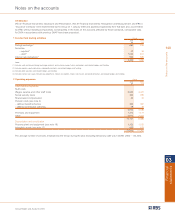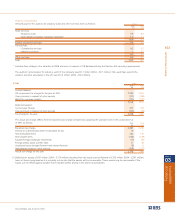RBS 2005 Annual Report Download - page 145
Download and view the complete annual report
Please find page 145 of the 2005 RBS annual report below. You can navigate through the pages in the report by either clicking on the pages listed below, or by using the keyword search tool below to find specific information within the annual report.
section
03
Financial
statements
143
Accounting policies
Annual Report and Accounts 2005
estimates and consequently actual losses incurred may differ
from those recognised in these financial statements.
Collective component – this is made up of two elements: loan
impairment provisions for impaired loans that are below individual
assessment thresholds (collective impaired loan provisions)
and for loan losses that have been incurred but have not been
separately identified at the balance sheet date (latent loss
provisions). These are established on a portfolio basis taking
into account the level of arrears, security, past loss experience,
credit scores and defaults based on portfolio trends. The most
significant factors in establishing these provisions are the
expected loss rates and the related average life. These portfolios
include credit card receivables and other personal advances
including mortgages. The future credit quality of these portfolios
is subject to uncertainties that could cause actual credit losses to
differ materially from reported loan impairment provisions. These
uncertainties include the economic environment, notably interest
rates and their effect on customer spending, the unemployment
level, payment behaviour and bankruptcy trends.
Pensions
The Group operates a number of defined benefit pension
schemes as described in Note 3 on the financial statements.
The assets of the schemes are measured at their fair value at
the balance sheet date. Scheme liabilities are measured using
the projected unit method, which takes account of projected
earnings increases, using actuarial assumptions that give the
best estimate of the future cash flows that will arise under the
scheme liabilities. These cash flows are discounted at the
interest rate applicable to high-quality corporate bonds of the
same currency and term as the liabilities. Any surplus or deficit
of scheme assets over liabilities is recognised in the balance
sheet as an asset (surplus) or liability (deficit). In determining the
value of scheme liabilities, assumptions are made as to price
inflation, dividend growth, pension increases, earnings growth
and employees. There is a range of assumptions that could be
adopted in valuing the schemes’ liabilities. Different assumptions
could significantly alter the amount of the deficit recognised in
the balance sheet and the pension cost charged to the income
statement. The assumptions adopted for the Group’s pension
schemes are set out in Note 3 on the financial statements. The
pension deficit recognised in the balance sheet at 31
December 2005 was £3,735 million (2004 – £2,940 million).
Fair value
Financial instruments classified as held-for-trading or
designated as at fair value through profit or loss and financial
assets classified as available-for-sale are recognised in the
financial statements at fair value. All derivatives are measured at
fair value. In the balance sheet, financial assets carried at fair
value are included within Treasury and other eligible bills, Loans
and advances to banks, Loans and advances to customers,
Debt securities and Equity shares as appropriate. Financial
liabilities carried at fair value are included within the captions
Deposits by banks, Customer accounts, Debt securities in issue
and Subordinated liabilities. Derivative assets and Derivative
liabilities are shown separately on the face of the balance
sheets. Gains or losses arising from changes in fair value of
financial instruments classified as held-for-trading or designated
as at fair value through profit or loss are included in the income
statement. Unrealised gains and losses on available-for-sale
financial assets are recognised directly in equity unless an
impairment loss is recognised. The carrying value of a financial
asset or a financial liability carried at cost or amortised cost that
is the hedged item in a qualifying hedge relationship is
adjusted by the gain or loss attributable to the hedged risk.
Fair value is the amount for which an asset could be exchanged,
or a liability settled, between knowledgeable, willing parties in
an arm's length transaction. Fair values are determined by
reference to observable market prices where available and
reliable. Where representative market prices for an instrument
are not available or are unreliable because of poor liquidity, the
fair value is derived from prices for its components using
appropriate pricing or valuation models that are based on
independently sourced market parameters, including interest
rate yield curves, option volatilities and currency rates.
Financial assets carried at fair value include government, asset
backed and corporate debt securities, reverse repos, loans,
corporate equity shares and derivatives. Financial liabilities
carried at fair value include deposits, repos, short positions in
securities and debt securities issued. Fair value for a substantial
proportion of these instruments is based on observable market
prices or derived from observable market parameters. Where
observable prices are not available, fair value is based on
appropriate valuation techniques or management estimates.
The Group’s derivative products include swaps, forwards,
futures and options. Exchange traded instruments are valued
using quoted prices. The fair value of over-the-counter
instruments is derived from pricing models which take account
of contract terms, including maturity, as well as quoted market
parameters such as interest rates and volatilities. Most of the
Group’s pricing models do not entail material subjectivity
because the methodologies utilised do not incorporate
significant judgement and the parameters included in the
models can be calibrated to actively quoted market prices.
Values established from pricing models are adjusted for credit
risk, liquidity risk and future operational costs.
A negligible proportion of the Group’s trading derivatives are
valued directly from quoted prices, the majority being valued
using appropriate valuation techniques. The fair value of
substantially all securities positions carried at fair value is
determined directly from quoted prices.
Details of financial instruments carried at fair value are given in
Note 34 on the financial statements.
General insurance claims
The Group makes provision for the full cost of settling outstanding
claims arising from its general insurance business at the
balance sheet date, including claims estimated to have been
incurred but not yet reported at that date and claims handling
expenses. General insurance claims provisions amounted to
£4,913 million at 31 December 2005 (2004 – £4,504 million).
Provisions are determined by management based on
experience of claims settled and on statistical models which
require certain assumptions to be made regarding the
























